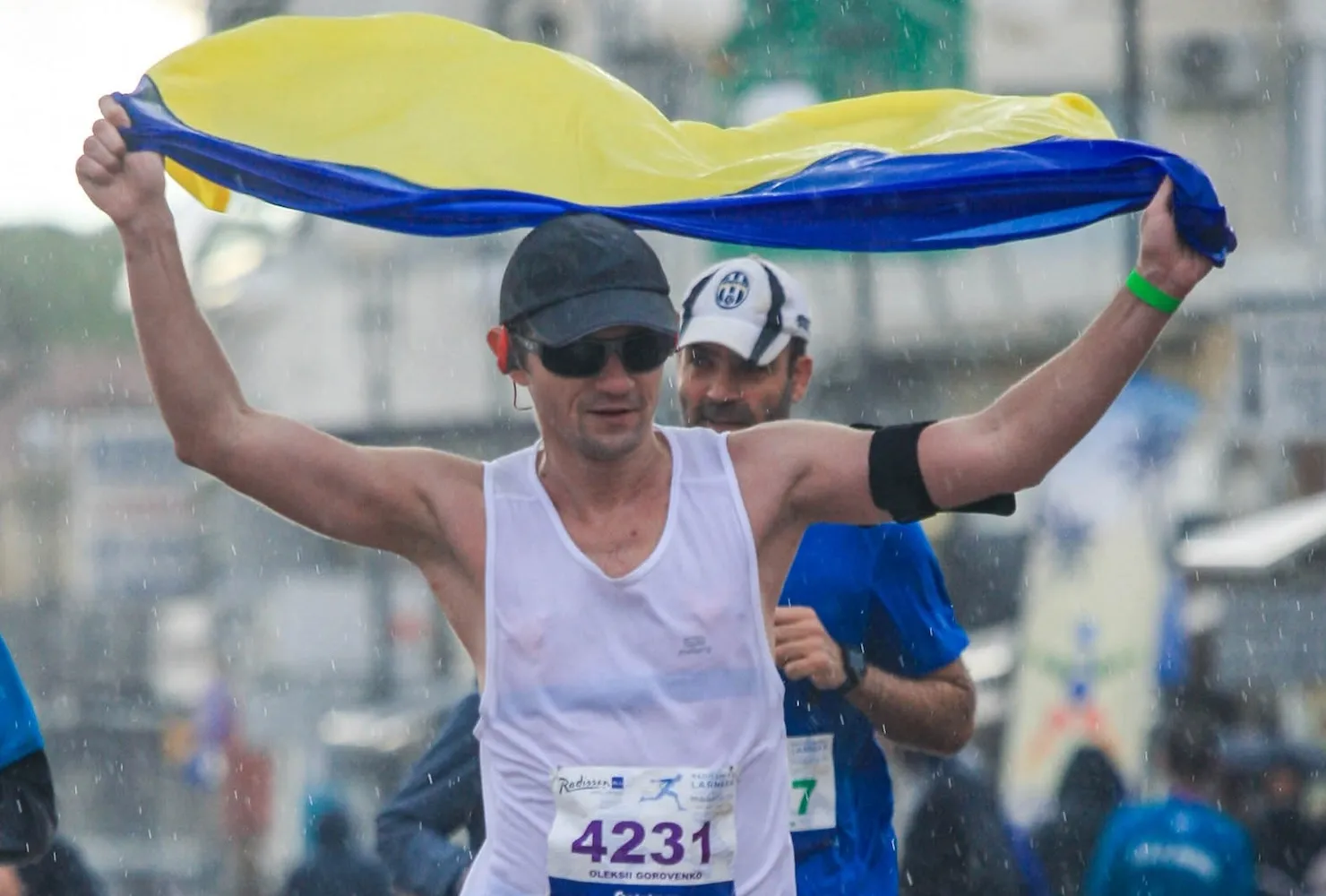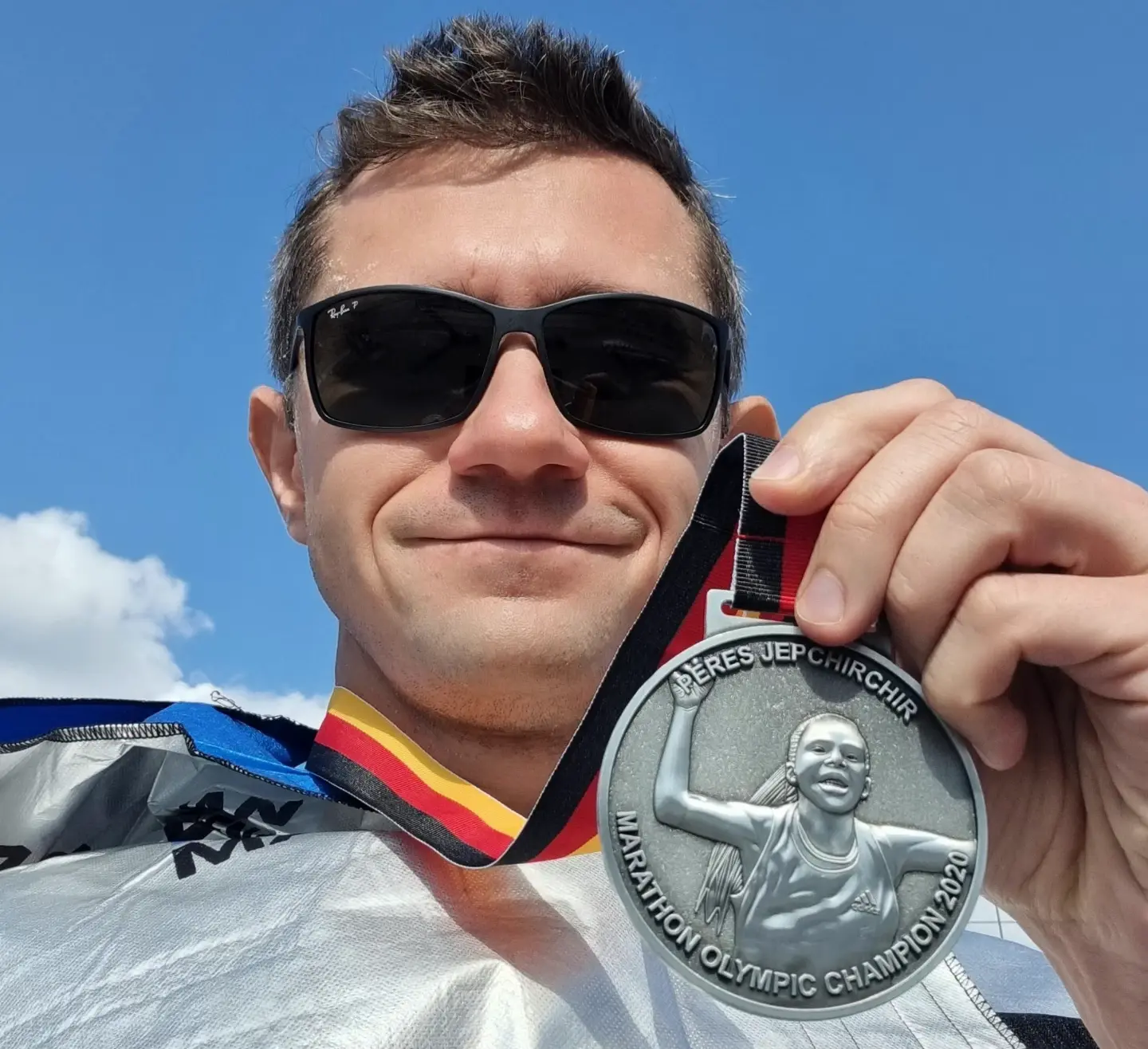Time:
4:11:30
Fueling:
- 4 SIS Isotonic Energy Gel
- Bananas
- Powerade
Gear:
- Saucony Endorphin Shift
- Oakley glasses
- Decathlon white singlet
- Headsets JBL Endurance JUMP
- Phone holder
- Plastic shorts
- Cotton socks
- Cotton cap
- Garmin HRM-Dual belt
Training
My preparation for my first marathon had been anything but systematic. There was no structured training plan, and no professional coach guiding me.
During the base period, I was running only 10 to 30 kilometers a week. From a professional runner I watched on YouTube I learned that running at least 50 kilometers a week was critical to crossing the marathon finish line. So, two weeks before the marathon I finally pushed my mileage to around 50 kilometers.
Occasionally, I added a few short interval workouts, running faster than my goal pace, hoping that these haphazard efforts would be enough.
In the final weeks, I managed two 30-kilometer training runs. The most recent was just a fortnight before race day. I clocked in at 2 hours and 41 minutes, holding an average 5:20 pace. That run was a small victory. It enhanced my confidence, that I could secure my first marathon in under four hours (5:40 per kilometer pace).
Before the race
The week before the race was all about tapering, carb-loading, and traveling. My family and I headed to the race destination, their excitement mingling with my anxiety. My brother was running the marathon with me, while my father was set for the half-marathon. They were the ones who had inspired me to take up running in the first place. The race was special for us, this was our shared adventure.
Early Miles
As the starting gun fired, I surged forward, adrenaline and excitement overriding the careful plans I had made. Like many first-time marathoners, I made the classic mistake: I started too fast. Despite my initial plan, my legs moved easily at a 5:15 per kilometer pace. It felt good, so good that I ignored the voice in my head warning me to slow down. I felt invincible.
After the first few kilometers, I noticed a girl about my age running alongside an older man. A father-daughter duo, I guessed. They moved with grace, and determination, matching my 5:15 pace. In the first half, we moved side-by-side, keeping our pace steady. My breathing was even and my heart rate was stable, just below my threshold zone of 165 bpm.
However, around the halfway mark, the duo passed me effortlessly, igniting frustration in me. I wanted to match their stride, but I quickly realized I couldn't keep up. I've resigned myself to the idea that they must be better prepared and I don't have to prove anything to them.
I slowed down to a 5:30 pace for the next 5 kilometers. My legs began to feel heavy, my energy reserves were depleting rapidly, and fatigue set in. It was clear that the gels I had been consuming weren’t enough.
I had to slow down even further to a 6:00 per kilometer pace. Normally, this is my "golden pace," one I can sustain indefinitely. But not today. This pace, which usually feels so comfortable, now seemed impossible to maintain.
Hitting the Wall
The 31st kilometer was the real turning point. It was the first significant incline on an otherwise flat course. To make matters worse, this was uncharted territory for me. I had never run more than 30 kilometers in training. The mental and physical struggle began in earnest. Motivational music blaring in my ears did little to help. My strength evaporated. This was the wall, the infamous barrier every marathoner dreads.
By the 34th kilometer, I was forced to stop running and transitioned to walking. My quads cramped painfully, and my calves were one step away from spasms too. Exhaustion had fully set in. Each step was a negotiation with my legs, a plea for them to keep moving. I set short, desperate goals: reach the next tree, the next lamppost before attempting to run again. At the next aid station, I devoured two bananas and gulped down isotonic drinks—food I hadn't taken earlier. Icing my quads brought a brief relief, but the pain and anticipation of cramps soon returned.
After two short walking intervals and some much-needed nutrition, I managed to resume running, but my goal of finishing in under four hours was gone. Now, the only thought on my mind was completing the distance, which was an achievement still.
For a moment, I considered quitting, but I was in the middle of nowhere, with no taxis or public transport around, and the shortest way out was forward. Besides, my family was waiting for me at the finish line, and all my belongings were there too. I had to get there somehow, and walking would take forever.
Surprisingly, this thought—"You need to get to the finish line because someone is waiting for you and all your belongings are there"—became my mantra in this and all subsequent races. It helped me accept that quitting wasn't an option and that running, however slowly, was always better than walking.
After a couple of short walking intervals and some much-needed nutrition, I managed to resume running.
Downpour
About 5 kilometers from the finish, the skies opened up, unleashing a torrential downpour, drenching me to the bone. My sneakers squished with each step, my clothes clung to my skin, and the world around me blurred as sheets of rain poured down. Puddles on the even road were forming faster than the water could drain away. It felt like a mini-flood.
Yet, the rain also brought some relief. It cooled my body and washed away the salt and sweat from my skin. I found myself thinking that maybe, just maybe, I could speed up. Not to chase a time, but to escape the cold. I was nearing the city, and supporters began to appear along the route, their resounding cheers encouraged me to run even faster.
Final Stretch
With every kilometer, the remaining distance to the finish line seemed more and more negligible. I felt a glimmer of strength returning and started to accelerate. The soles of my feet hurt, but the pain was bearable. I forgot about the pain in the rest of my body: quads, calf, back, neck. The thought of finishing strong pushed me forward.
The closer I got to the finish line, the faster I ran. I had recovered enough over the last few kilometers to accelerate, and soon I was running at the pace I had started with. I felt like I had rested too much earlier. I was overtaking exhausted runners left and right.
About 500 meters from the finish, I saw my father. He stood by the course, holding out our national flag for me. I grabbed it, a surge of pride and emotion welling up inside me. The final stretch was emotional and memorable for me. My wife, daughter, and mother greeted me at the finish line, along with my brother, who had finished 12 minutes earlier.
Aftermath
In the immediate aftermath, I felt an overwhelming mix of relief and exhaustion. My time goal remained unmet, but I finished strong, with my head held high. My brother later told me he had expected me to overtake him at some point, but I never did.
Despite the pain and struggles, I didn't vomit, suffer injuries, make an unexpected porta-potty stop, or experience chafing or black toenails. Looking back, I realized I had done many things right:
- Completed 30-kilometer runs beforehand
- Carb-loaded without trying new foods
- Wore well-tested sneakers and a singlet
- Used an anti-chafing band on my nipples
- Rested well the week before the race
- Tested my fuel strategy during training
- Used familiar gear on race day
If I could go back and do it all over again, there are only a few things I would change:
- Start at a slower pace and stick to it, no matter how tempting it is to speed up
- Take electrolytes before, during, and after the race. At the time, I didn't realize how crucial sodium was in preventing cramps
- Log an additional 3-4 weeks of 50 kilometers each to build a more solid base
As I stood there immediately after crossing, soaked to the skin, with my family cheering around me, I knew this race had given me something far more valuable than a time goal. It has given me a lesson in resilience, in finding the strength to keep moving forward when every part of you wants to stop.
As I walked away from the finish line, I had no desire to sign up for another marathon. Yet, I didn't rule out the possibility either. My marathon time goal was still unmet, and the thought of achieving it lingered, a challenge that would call me back soon.

